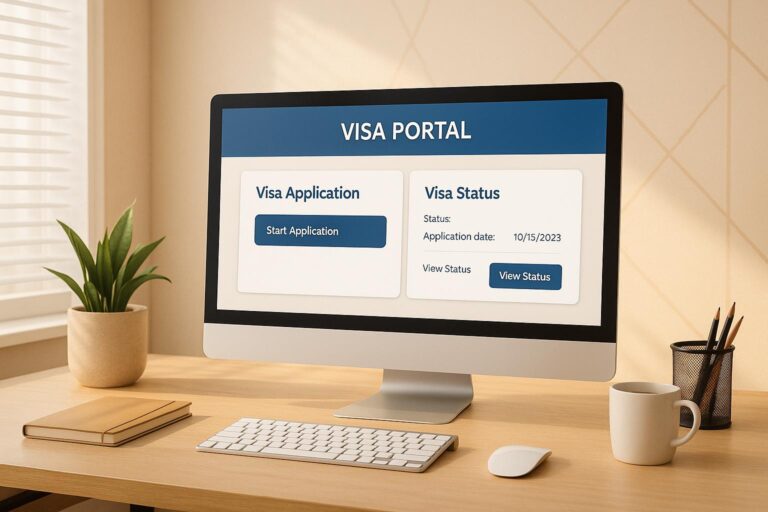Managing employee visas can be complex and time-consuming. Self-service portals simplify this process by allowing employees and HR teams to handle visa applications, renewals, and compliance digitally. These platforms save time, reduce errors, and improve communication, making them essential for businesses navigating immigration regulations. Here’s a quick overview of the main advantages:
- Simplified Applications: Employees can manage their visa process in one secure platform, with features like document storage, real-time tracking, and mobile access.
- Error Reduction: Automation ensures forms are accurate, reducing mistakes and rejections.
- Improved Employee Experience: Real-time updates and centralized communication keep employees informed and stress-free.
- Faster Processing & Lower Costs: Automation cuts administrative work, saving time and money for HR teams.
- Compliance Tracking: Automatic alerts and real-time dashboards help avoid missed deadlines and costly fines.
Self-service portals streamline visa management, offering efficiency, accuracy, and peace of mind for both employees and employers.
1. Easier Visa Applications and Document Storage
Dealing with visa applications through email or paper can be a real hassle. Self-service portals simplify the process by offering a single, secure platform where employees can manage their entire visa application journey from start to finish.
With everything centralized, employees can access the platform anytime – no more scrambling to find lost attachments or sending out endless follow-up emails. This is especially helpful for teams working remotely or on irregular schedules.
The platform also provides a secure space for uploading and organizing important documents like passports, visa forms, and I-94s. No more misplaced files or long email chains clogging up inboxes. Plus, features like real-time tracking allow employees to monitor their application status, flag missing paperwork, and receive alerts for approaching deadlines, making the process smoother and more transparent.
Security is a top priority. Sensitive immigration documents are protected with encrypted transmission, role-based access, and secure cloud storage, ensuring only authorized users can access them.
The benefits of self-service portals are clear. A 2023 survey by DM Payroll Solutions found that companies using these systems saw a 30% drop in document processing errors compared to manual methods. They also reported onboarding and document handling speeds improving by up to 50% when employees took charge of their own submissions.
For organizations using comprehensive HR platforms, the integration of visa tracking and document storage – like Skillfuel’s system – makes the transition from hiring to maintaining work authorization seamless. And with mobile compatibility, employees can snap photos of documents, upload them instantly, check statuses, and respond to alerts – all from their phones, no desktop required.
2. Fewer Errors and Better Data Quality
Filing visa applications manually often leads to mistakes – think of handwritten forms, misplaced email attachments, or errors from copying information across multiple documents. Self-service portals tackle these issues head-on with automated validation systems that catch errors early, saving time and headaches.
These portals use real-time validation to improve data accuracy. For example, they automatically format dates to the MM/DD/YYYY standard, require mandatory fields to be filled, and flag inconsistencies as users input data. Pre-filled forms take this a step further by pulling details like legal name, birth date, address, employment start date, and job title directly from HR databases. This eliminates the need for manual entry and reduces transcription errors. Advanced error-checking algorithms also ensure compliance with immigration standards, flagging potential issues before they become problems.
In 2023, data revealed that over 70% of companies using self-service portals saved HR teams more than 200 hours each month and cut processing costs by up to 40%.
Behind the scenes, error-checking algorithms confirm that entries align with current immigration requirements. These systems cross-reference visa categories with employment types, verify that supporting documents meet USCIS specifications, and notify employees if their submissions don’t meet regulatory standards. This proactive system helps minimize the risk of application rejections.
Platforms like Skillfuel further simplify the process by centralizing visa data. They log changes with timestamps and provide audit trails, ensuring compliance while preventing outdated or conflicting information from slipping through the cracks.
3. Better Employee Experience and Clear Communication
Visa applications can be overwhelming for employees, especially when they’re unsure about the status of their case or the next steps. Self-service portals change the game by offering real-time status updates and clear communication channels, giving employees more control and reducing uncertainty.
These portals act as a bridge between HR and employees, centralizing communication in one place. Instead of juggling countless emails or phone calls, employees can log in at any time to check the exact status of their case. Whether it’s an I-94 extension under review, an H-1B transfer approval, or a request for additional documents, the information is just a click away. This setup not only simplifies communication but also allows HR teams to respond faster and keep processes moving smoothly.
The convenience of 24/7 mobile access is a game-changer, especially for international employees working across time zones or traveling. Imagine checking your visa status during lunch in Tokyo or uploading required documents from a hotel room in London – these portals make it possible.
Employees can also access their full visa history, track document submissions with timestamps, and review past communications with immigration attorneys or HR staff. This eliminates the guesswork around what’s been submitted and when, making it easier to prepare for future applications. If they have questions about their Labor Condition Application or need clarification on supporting documents, they can send a message directly through the portal without hunting for the right contact.
What’s more, portals cut down on internal support costs while boosting employee satisfaction. For example, Skillfuel users have reported better transparency and fewer administrative delays, which has led to happier employees and higher retention rates. When employees feel informed and in control of their immigration journey, they’re more likely to trust their employer and stay focused on their work instead of stressing over visa issues.
This level of transparency also helps employees plan their personal lives with confidence. Knowing that their green card application has moved to the "Interview Scheduled" phase allows them to prepare accordingly, while seeing their work authorization renewal marked as "Approved" gives them peace of mind about their job security.
sbb-itb-e5b9d13
4. Faster Processing and Lower Costs for HR Teams
Self-service portals are revolutionizing how HR teams handle visa management. By automating routine tasks, these platforms eliminate the need for HR staff to manually track visa expiration dates, chase employees for documents, or input data across multiple systems. Instead, the portal takes care of these processes, cutting processing time from weeks to hours. This efficiency allows HR teams to handle more visa requests without hiring additional staff, resulting in noticeable cost savings.
According to a 2023 HR Tech survey, companies that adopted self-service portals saw a 30–40% reduction in time spent on repetitive HR tasks and up to 25% lower administrative costs within the first year of implementation. For a company with 500 employees, this could mean saving thousands of dollars annually by automating visa renewals and reducing reliance on external legal or administrative support.
Beyond automation, centralized management adds another layer of efficiency. With all visa-related activities accessible through a single dashboard, HR managers can easily prioritize urgent cases, assign tasks, and monitor compliance without juggling spreadsheets or switching between systems. This streamlined approach frees HR teams to focus on strategic goals like talent acquisition and employee engagement, rather than getting bogged down by administrative chores.
For instance, a multinational company recently shifted significant HR resources away from visa management and toward initiatives like onboarding and retention. This reallocation not only improved organizational productivity but also allowed the HR team to contribute more meaningfully to the company’s long-term goals.
Self-service portals also eliminate common bottlenecks. Automated reminders ensure employees submit documents and renewals on time, preventing last-minute scrambles. Real-time status tracking and integrated communication tools further minimize delays by reducing back-and-forth communication, ensuring all requirements are met before submission.
| Processing Aspect | Manual Management | Self-Service Portal |
|---|---|---|
| Processing Time | Days to weeks | Hours to days |
| HR Workload | High administrative burden | Significantly reduced |
| Error Rate | Higher due to manual entry | Lower through automation |
| Operational Cost | Higher (labor, errors, delays) | Lower (automation, fewer errors) |
These benefits become even more pronounced as organizations grow. Self-service portals enable HR teams to handle increasing volumes of visa requests without adding staff or resources. They also ensure consistency and compliance across multiple locations, which is especially valuable as companies expand into new markets. This shift from manual processes to employee-driven management ties directly to earlier advantages like enhanced communication and precision in visa handling.
The impact goes beyond immediate cost savings. By reducing reliance on HR for routine visa tasks, organizations empower employees to manage their own immigration needs. This not only boosts efficiency and lowers costs but also allows HR teams to focus on initiatives that directly improve employee satisfaction and retention.
Platforms like Skillfuel highlight how automation and centralized data management can transform visa processing. By enabling employees to take charge of their visa-related tasks, businesses turn administrative challenges into opportunities for strategic growth.
5. Automatic Compliance Tracking and Alerts
Navigating U.S. immigration regulations can be a daunting task for HR teams managing employee visas. Missing a deadline or failing to update documentation doesn’t just create headaches – it can lead to fines ranging from $272 to $2,701 per violation, according to the U.S. Department of Labor‘s 2024 rates. Self-service portals take much of this stress off HR’s shoulders by continuously monitoring compliance and sending automated alerts.
These portals go beyond streamlining processes – they actively minimize risks. They track critical details like visa expiration dates, document renewal deadlines, and regulatory updates. For example, if an H-1B visa is set to expire in 90 days, the system notifies both the employee and HR, with follow-up reminders at 60 and 30 days to ensure no deadlines slip through the cracks.
But it’s not just about deadlines. Whenever U.S. immigration policies change, these systems automatically update compliance requirements and notify the relevant parties. This ensures that everyone involved is aware of new documentation or filing procedures without delay.
A compliance dashboard provides real-time insights into the workforce’s visa status. HR managers can quickly spot upcoming renewals, identify missing paperwork, and focus on cases needing immediate attention. Additionally, these systems generate detailed audit trails, which are invaluable for internal reviews or government audits. By integrating this level of compliance management into a digital visa management strategy, HR teams can stay ahead of potential issues.
The importance of automated compliance tracking is clear. A Deloitte survey found that 56% of organizations consider compliance a key reason for investing in HR technology like self-service portals. Companies using these tools have reported up to a 40% drop in compliance-related incidents and a 30–50% reduction in missed deadlines. Not only does this cut down on administrative work, but it also helps organizations avoid hefty fines.
| Compliance Feature | Manual Tracking | Self-Service Portal |
|---|---|---|
| Deadline Monitoring | Spreadsheets and manual checks | Real-time automated alerts |
| Policy Updates | Email chains and meetings | Instant system-wide notifications |
| Audit Preparation | Paper files and scattered records | Centralized digital documentation |
| Error Rate | High due to human oversight | Significantly reduced through automation |
Self-service portals are designed to handle various visa types – H-1B, L-1, O-1, green cards – each with its own compliance calendar. Platforms like Skillfuel demonstrate how centralized dashboards and automated alerts can overhaul compliance management. By combining visa workflows with these tools, HR teams can significantly lighten their administrative load while ensuring they remain compliant with immigration laws.
This automated approach not only protects organizations from costly violations but also strengthens the efficiency and cost savings achieved through digital visa management systems.
Conclusion
Employee visa self-service portals are transforming how organizations manage international talent, making the process smoother and more efficient for everyone involved. By integrating the benefits discussed earlier, these platforms create a streamlined ecosystem for visa management.
Companies adopting these portals see tangible improvements: faster processing times, fewer application errors, and lower administrative costs – all while boosting employee satisfaction rates. What was once a confusing and opaque process becomes transparent and employee-centered. Features like real-time visa status tracking, automated reminders, and 24/7 document access from any device help reduce the stress often tied to visa applications. This combination of autonomy and clarity leads to more engaged and satisfied employees.
Automated compliance tools are another key advantage, offering organizations a reliable way to meet regulatory requirements while cutting down on administrative workloads.
Skillfuel’s integrated platform is a prime example of how HR technology can elevate the employee experience. By merging recruitment management with visa compliance tools, it creates seamless workflows that support employees from the moment they’re hired through the entire visa process. This ensures companies stay compliant while fostering a positive work environment.
The move to digital visa management isn’t just about efficiency – it’s about creating a process that’s accurate, user-friendly, and aligned with the needs of today’s global workforce. Self-service visa portals are no longer a luxury; they’re a necessity for staying competitive while maintaining compliance and keeping employees happy.
FAQs
How do self-service portals improve the security of sensitive immigration documents?
Self-service portals strengthen the security of immigration documents by storing sensitive information in a centralized, encrypted system. This approach eliminates the need for physical paperwork, which can easily go missing or be mishandled, and significantly reduces the risks tied to sharing documents through email.
These portals also come equipped with features like role-based access controls, ensuring that only authorized individuals can view or update specific details. On top of that, real-time tracking and audit trails provide added transparency, allowing organizations to keep tabs on who accessed or modified documents and when.
How do self-service portals help reduce HR administrative costs?
Self-service portals simplify visa management by automating tasks like document submissions and status updates. This automation takes a significant load off HR teams, reducing the chance of errors that could lead to costly corrections or delays.
These portals also empower employees to handle their own visa-related information without needing constant assistance from HR. This not only cuts down on unnecessary back-and-forth communication but also boosts efficiency, trims administrative expenses, and creates a smoother, more positive experience for employees.
How do self-service portals enhance the visa application experience for employees?
Self-service portals make the visa application process easier by putting employees in the driver’s seat. They can track their application status, upload documents, and stay updated – all from a single platform. This centralized approach reduces confusion and eliminates unnecessary stress, creating a smoother experience.
These portals also cut down on mistakes by providing clear instructions and built-in automated checks. This not only saves employees time but also lightens the workload for HR teams. By simplifying the process, self-service portals boost satisfaction and create a more seamless experience for everyone involved.












